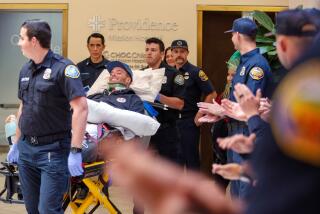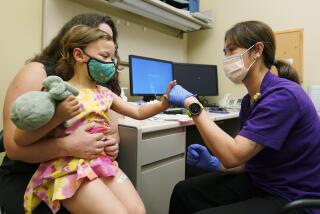Hawaiian Boy Rushed to O.C.; Donor Heart Still Sought : Health: Children’s Hospital of Orange County sent a special nine-member team to Hawaii to bring the critically ill child to Orange County.
- Share via
A 2-year-old Hawaiian boy desperately in need of a heart transplant arrived at John Wayne Airport on Sunday night with a team of medical personnel from Children’s Hospital of Orange County, as his family waited for word that a donor heart had been found for the critically ill child.
Jason Jennette and a nine-member medical team from CHOC landed at 10 p.m. They were greeted by the boy’s parents, Jason and Darlene Pacheco of Pepeekeo, Hawaii, who had arrived Saturday night.
The child, who was connected to medical equipment throughout the flight from Hawaii, was transferred by ambulance to the CHOC facility in Orange.
Hospital officials said Jason will remain there until surgeons at Loma Linda University Medical Center in San Bernardino County can locate a donor heart.
Officials with CHOC and Loma Linda rushed to help the toddler after hearing about his plight.
Jason was born with a congenital heart defect, a disease that afflicts 1 in 6,000 babies. Heart transplants are not available in Hawaii, and Jason’s heart was slowly deteriorating, Andrea Pronk, a CHOC spokeswoman, said.
On Saturday, CHOC dispatched a special medical team to Hawaii to bring the child to Orange County.
The team took along a heart-lung bypass machine, an apparatus developed by CHOC in the 1970s to take the place of an infant’s heart and lungs. The machine takes stress off weakened organs.
Hospital officials said that the machine, known as ECMO, or Extracorporeal Membrane Oxgenation, pumps blood out of the infant’s body and into an artificial lung, which provides oxygen the way a human lung would. The blood then passes through a heat exchanger, where it is warmed before it flows back into the child’s body.
Jason was hooked up to the machine Saturday, shortly after the CHOC team arrived in Hawaii. The boy’s doctors soon realized that the child would not be able to be flown to Orange County in a commercial aircraft because the machine would not fit through the plane’s smaller doors.
“Once the child is connected to the machine, (the machine) cannot be dismantled to accommodate another aircraft,” Pronk said.
Coast Guard officials agreed to help. They offered a C-130 Hercules cargo plane--like the ones the U.S. military recently used for airdrops over Bosnia--to fly Jason on the 7 1/2-hour trip from the Barber’s Point base near Honolulu to Orange County.
“All other sources of transport were unavailable, so we thought we would jump in and help,” Petty Officer William Atkinson of the Coast Guard’s Long Beach station said.
Hospital officials say Jason will need lots more help in the next few days and weeks.
He is on a list of dozens of infants around the nation waiting for a donor heart. Officials are not certain how long he will have to wait and would not speculate how long Jason can survive without a heart transplant.
“In some cases, we have procured a heart the same day, and in others it takes up to six months,” said Anita Rockwell, a spokeswoman for Loma Linda University hospital, which has been a pioneer in infant heart transplants since 1985.
“We have not been as successful this year getting hearts as other years,” Rockwell said. “We need to make the public more aware that donations of hearts are needed for infants.”
More to Read
Sign up for Essential California
The most important California stories and recommendations in your inbox every morning.
You may occasionally receive promotional content from the Los Angeles Times.










